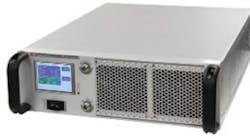Testing RF/microwave circuits and devices often requires some kind of a boost, in terms of increasing the power level of a test signal before it is detected by an analyzer. When generous test-signal levels as high as 50 W might be needed, there is the model 2135-BBS3G6QHM (SKU 2135) linear high-power amplifier from EMPower RF Systems. It was developed to help out with RF and microwave component testing, as well as to provide the test levels needed for electromagnetic-compatibility (EMC) and radio-frequency-interference (RFI) immunity and susceptibility testing. The air-cooled amplifier is supplied in a single R3U-high rack-mount chassis. It covers the 300-to-3800-MHz instantaneous frequency band with 50 W of solid-state output power.
The model 2135-BBS3G6QHM (see figure) is actually two amplifiers in one housing. Silicon laterally diffused metal-oxide-semiconductor (LDMOS) technology is applied for frequencies from 20 to 1000 MHz, while gallium arsenide (GaAs) field-effect-transistor (FET) technology used for the frequency range from about 800 to 3800 MHz.
The amplifier is designed to be a suitable companion to most test instruments, being equipped with a microprocessor-controlled liquid-crystal-display (LCD) front-panel display screen for monitoring and control. The amplifier's operational status is also available along numerous standard interfaces, including GPIB/IEEE-488, RS-422, and TCP/IP Ethernet, which also support remote control via a personal computer (PC) for use in automatic-test-equipment (ATE) setups. The amplifier's linearity and low distortion make it suitable for a wide range of signals. The model 2135-BBS3G6QHM amplifier is designed to operate with both an open-loop gain adjustment mode or in an automatic-level-control (ALC) mode.
The amplifier delivers 80 W minimum saturated CW output power and 50 W minimum output power at 1-dB compression in its low frequency band (to 1000 MHz), with 50 W minimum saturated CW output power and 50 W typical output power at 1-dB compression in its high band (to 3800 MHz). It achieves 46-dB minimum gain at 1-dB compression in the low band and 48-dB typical gain at 1-dB compression in the high band.
The rack-mount amplifier features worst-case gain flatness of 2 dB across its full frequency range. It includes a voltage-variable-attenuation (VVA) range of at least 25 dB to modify the gain, with typical noise figure of 10 dB across the full frequency range. The amplifier hits a typical third-order intercept point of +56 dBm. Second harmonics are typically -40 dBc in the low band and -20 dBc in the high band, while maximum spurious levels are -73 dBc. The maximum input return loss is 10 dB.
The rugged amplifier handles single-phase operating voltages from 100 to 240 VAC, with typical AC power consumption of 600 W. It uses Type N female input and output connectors, measures 19.0 x 5.25 x 22 in., and weighs 50 lbs. It is designed for ambient operating temperatures of 0 to +50C and storage temperatures of -40 to +85C. It has been constructed to meet the typical airborne environmental requirements of MIL-STD-810F, Method 516.5 for shock and vibration and to operate at attitudes to 30,000 ft. per MIL-STD-810F.
The amplifier includes a variety of internal protection schemes: It is protected against input overdrive for levels to +6 dBm; immune to an infinite load VSWR at all phases and amplitudes for a duration of one minute; and can also withstand a load VSWR of as high as 3.0:1 for all amplitudes and phases continuously. MWRF
Empower RF Systems, Inc., 316 W. Florence Ave., Inglewood, CA 90301; (310) 412-8100, FAX: (310) 412-9232, e-mail: [email protected], www.EmpowerRF.com.

